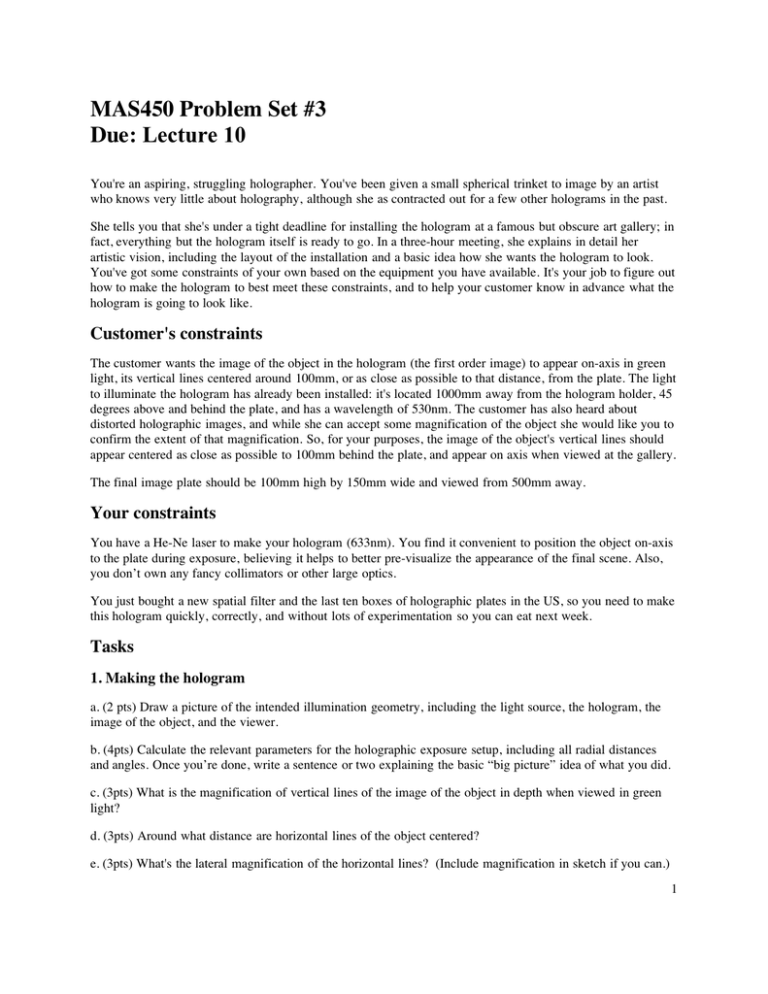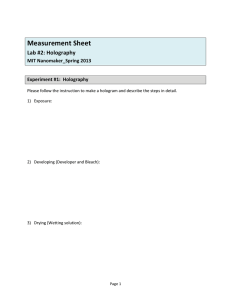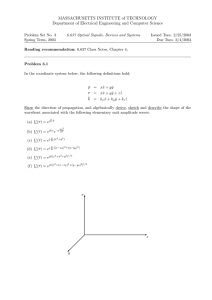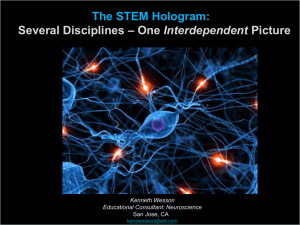MAS450 Problem Set #3 : Lecture 10 Due
advertisement

MAS450 Problem Set #3 Due: Lecture 10 You're an aspiring, struggling holographer. You've been given a small spherical trinket to image by an artist who knows very little about holography, although she as contracted out for a few other holograms in the past. She tells you that she's under a tight deadline for installing the hologram at a famous but obscure art gallery; in fact, everything but the hologram itself is ready to go. In a three-hour meeting, she explains in detail her artistic vision, including the layout of the installation and a basic idea how she wants the hologram to look. You've got some constraints of your own based on the equipment you have available. It's your job to figure out how to make the hologram to best meet these constraints, and to help your customer know in advance what the hologram is going to look like. Customer's constraints The customer wants the image of the object in the hologram (the first order image) to appear on-axis in green light, its vertical lines centered around 100mm, or as close as possible to that distance, from the plate. The light to illuminate the hologram has already been installed: it's located 1000mm away from the hologram holder, 45 degrees above and behind the plate, and has a wavelength of 530nm. The customer has also heard about distorted holographic images, and while she can accept some magnification of the object she would like you to confirm the extent of that magnification. So, for your purposes, the image of the object's vertical lines should appear centered as close as possible to 100mm behind the plate, and appear on axis when viewed at the gallery. The final image plate should be 100mm high by 150mm wide and viewed from 500mm away. Your constraints You have a He-Ne laser to make your hologram (633nm). You find it convenient to position the object on-axis to the plate during exposure, believing it helps to better pre-visualize the appearance of the final scene. Also, you don’t own any fancy collimators or other large optics. You just bought a new spatial filter and the last ten boxes of holographic plates in the US, so you need to make this hologram quickly, correctly, and without lots of experimentation so you can eat next week. Tasks 1. Making the hologram a. (2 pts) Draw a picture of the intended illumination geometry, including the light source, the hologram, the image of the object, and the viewer. b. (4pts) Calculate the relevant parameters for the holographic exposure setup, including all radial distances and angles. Once you’re done, write a sentence or two explaining the basic “big picture” idea of what you did. c. (3pts) What is the magnification of vertical lines of the image of the object in depth when viewed in green light? d. (3pts) Around what distance are horizontal lines of the object centered? e. (3pts) What's the lateral magnification of the horizontal lines? (Include magnification in sketch if you can.) 1 2. Customer evaluation The customer shows up to evaluate and claim the hologram, but you have no green light source with which to view it. You make a desparate choice and take the hologram outside in the sun to view. You set up a viewing station so that the hologram is illuminated at 45 degrees, just as you'd planned. a. (3pts) What do you and the customer see? (include a qualitative description or sketch) b. (4pts) Find the position (radial distance and angle) of the image of the object in three wavelengths from the sun: 633nm, 530nm, 470nm. Draw a side view of the viewing geometry, including these three images. Use only the horizontal focus to simplify the work (the vertical focus is more appropriate for use here, though). c. (3pts) The customer is just not happy with the image, and in a fit of desperation flips the plate twice, first around its vertical axis, then around its normal vector. Thinking quickly, you realize that the hologram is now being illuminated by the sun from exactly the opposite angle as it was before. As a result, you intuit, made the m=-1 order visible. Sketch the new illumination geometry, with the plate, viewer, sun's rays and object's image (470nm, 530nm, and 633nm, horizontal focus only). You blame the poor image quality on the sun and on other indescribable limitations of holography, assure the customer the hologram will look great in the installation, collect your money and send her on her way. 3. Scuttlebutt and the big surprise Your task completed, you continue to live your meager and frugal holographer existence. You hear through the grapevine some months later, though, that your customer made a last minute change to the setup and installed a long, florescent-like tube to light the hologram instead of using a point source. From what your friends tell you, the tube is about a quarter of a meter long and its oriented vertically behind the hologram but tipped so the entire length of the tube is still about a meter from the plate. The wavelength of the light from the tube apparently hasn't changed. (4pts) Assuming the hologram is lit from the original direction (not flipped around as in 2c), what will the image look like under this new green light? Once again, draw the viewing geometry. Do some calculations that quantify the extent of any problems that have arisen from the change in light source. Don't belabor the computation with amazing accuracy; your information is sketchy and you've got your money. 2


